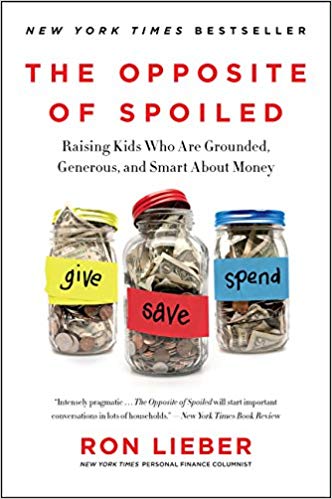This post may contain affiliate links. Read our disclosure here.

A few months ago a reader asked the following question on Facebook: “Any tips on the best ways to get started teaching children to handle money well? I’d rather not pay them for chores but how else would they earn money?” Not surprisingly, there were lots of great responses!
Our readers have many different perspectives on how best to do this, but it’s obvious that many of you have thought a lot about how to teach kids about money. I’m eager to share their advice with you and to hear your own thoughts in the comments on this post!
Reader Question: How to Teach Kids About Money
One perspective that came up in the comments was the idea of giving your child a set amount of money each month but not to tie it to anything (like chores). The idea of this is to just give kids the opportunity to learn how to manage money. Here are some readers’ thoughts:
Brooke G.: “When I was a kid, we got $10 twice a month when Dad got paid. No chores required; it was just for the purpose of learning about money. We were required to tithe $1 and to put $4 in the bank, and if we put the remaining $5 in the bank Dad would match it. We were allowed to pull money out of the bank for something big with Dad’s permission.”
Melissa S.: “My kids started getting an allowance at 5, but I’m mean & won’t buy them toys or junky stuff. They started learning to manage their money quickly! They do chores because they’re a contributing member of our household. They get their allowance for the same reason. Allowance has increased incrementally with age.”
Andrea C.: “From age 8-16 we give an allowance (very modest) but enough for them to have money to practice managing. Not enough to meet all of their wants, so there’s motivation to work for more. It is tied to chores or grades in NO way at all. You do those things because you’re supposed to (my kids do a lot of chores b/c they live here and keep privileges for good grades). No one is ever going to pay you to do those things in life.”
Heidi I.: “I give my kids a certain amount of money weekly. They are responsible to buy their “wants.” Of course, we buy them gifts and small things here and there. But majorly, they buy things: an Icee, that toy they really want, etc. At first, my oldest kept running out of money… asking for a loan and not managing it well. Now, he’s had $60 since June and is spending very responsibly. My middle is very tight and doesn’t spend often. Sweetly though, she spends on others. I don’t tie money to chores. I feel like the money is teaching them to make choices. Sometimes, bad choices take a long time to recover from. Chores are their contribution to the family and to help mom.”

Other parents don’t tie money to basic chores that are expected as being part of the household, but do pay for chores done that are above and beyond normal chores.
Michelle M.: “I would only pay for extra work since the regular chores are a part of living in a family. I’d write any extra jobs I wanted done (cleaning out the silverware drawer, washing the dog, organizing cabinets, etc.) on a notecard and post it on the fridge. It would list the job, the pay, and when it ‘expired.'”
Pamela E.: “We pay for extra things. There are chores she is required to do. There is a list of chores she can do for extra: help rake leaves, wash the car, tidy the garage, clean out a closet. She was able to buy a few items for Christmas for some close friends.”
Kathy T.: “They have to basically clean up after themselves and their pets, and then can get paid for extra chores. Sometimes there is a tip for an especially good job or something special that they have done.”
Gail M.: “I saw something that I thought was a really good idea. Makes a chart with various chores/jobs for children to do and assign each chore a dollar amount. The more difficult the chore, the more that job is worth. Let children choose the jobs they want to do. They can choose as many or as few chores as they want. But they will learn the harder you work, the greater the benefits.”
Carrie K.: “We pay for chores that are above and beyond their daily stuff. So they still have opportunities to earn. So daily chores include dishes, laundry, and general pick up. But extras to earn money would be stuff like washing windows, pulling weeds, cleaning baseboards, scrubbing bathrooms, or organizational projects (like helping in the garage, basement, etc.).”
Melissa P.: “We have core chores… these are non-negotiable and unpaid. They can choose to do other chores that have been assigned a small earning. They have to set 10% back for donations, 20% savings and the rest is theirs to spend as they see fit… with a catch. Screen time. They have to pay for that. They often choose not to watch anything to save money for other grand things like toys. Any advance that is given is paid back with compound interest over a period of time.”

Some parents give their kids money related to performance and work at school.
Jen W.: “Our 10 year old started offering to get a job a few years back. We explained to him, just how Daddy goes to work, you do too! Your job right now is to work on you, to become the best little man you can be. We translated that to monetary value since he wanted to buy his own ‘extras.’ Since we do school at home he gets a nickel for a 15 minute lesson, a dime for a 30, and a quarter for an hour. He loves it!”
Tarah M.: “I paid for great grades because I felt that the hours spent a week at school & good grades made were the equivalent of going to a job & getting a good review by a boss & a raise.”
Elizabeth C.: “Our oldest is in 4th grade, and we pay $10 per A, $5 per B. No money for anything lower than a B. Then we put that money in her savings account/college fund anyway, but she sees it as ‘her contribution’ instead of just something we put in.”
Stephanie L.: “We do $1/year raise, so, for instance, in 3rd grade you get $3/A, $1.50/B, nothing for below a B. In 4th grade you get a ‘raise’ to $4/A and $2/B. By the time they are in high school that will be a nice bonus!”
Chelsie W.: “I have always paid my son for grades. $5 for every A, nothing for a B or C, and if he gets an F, he has to pay me $5. I also give him a $100 bonus at the end of the year if he has gotten straight A’s the entire year (has to be all A’s). It has really motivated him to do well in school.”
Then we have the other end of the spectrum, with parents who do tie allowances and money to basic chores or to other work done around the house.
Laura Ruth: “My girls earned $3 a week. One dollar for chores done without having to be reminded, $1 for behavior, and $1 for school performance. They could earn $3, $2, $1 or nothing per week. Aside from Christmas, Easter and their birthday we bought them nothing except clothes if needed. They had 2 envelopes. One for immediate spending and one for long term wants. As they got older they took on jobs from neighbors and friends. Both grown and financially responsible.”
Amy R.: “I let my daughter be my assistant with my side craft job. She helps make lists, and makes sure that I have all the supplies ready for each project I need to do.”
Julie R.: “It’s been years since my kids were younger, but they had loadable debit cards and got an automatic allowance every payday for me. They had assigned jobs to earn the allowance just like I do to earn my salary. They had a bucket of tokens with jobs I wanted done like washing the dogs, cleaning baseboards, etc. They could pull those to earn more.”

Some parents explained how regardless of how their children got money, they required them to use their own money (however it was earned or received) to pay for certain items—both needs and wants.
Melissa W.: “Our oldest is 12. He gets $12 per week ($1 for every year old he is). $2.50 goes to church contribution. $2.50 goes to savings. $1 is paid back to me to help pay for school lunches and $ 1 is paid back to me to help pay for his trombone rental. These are his ‘bills.’ The remainder is his to spend however he wants. We also require him to keep a register of all money going in/out.”
Cheryl G.: “My daughter and son had one athletic activity that they were passionate about. When they wanted more expensive equipment, they had to fund the amount over the basic equipment price. They both figured out ways to earn the money.”
Kaylin T.: “My 7 year old wanted a Nintendo Switch. It took him 3 months in the summer to earn. He went to work with me to earn $3-$7/day. When he was able to purchase it, it made him well aware how much it took to get it. He was more careful and made sure not to leave it anywhere.”
Becki O.: “I think just making them use their own money to buy things they want works pretty well. Mine get money occasionally for doing out of the ordinary chores or in cards from grandparents.”
Sharon M.: “My daughter gets $20/month for doing her jobs. She has to put $4 in her pet envelope (to pay for something pet related once per yr like shots for her cat or dog, food ,litter etc), $4 in savings envelope and $1 in donation envelope (she chooses which charity or cause she wants to support).”
Kim N.: “When my daughter is 15, I’ll be doing what my dad did: $200 a month for school lunch, all clothes, running around with friends, and her phone bill.”
Becky B.: “I no longer buy them extra things—they have to use their chore money for that. I pay for food, necessary clothes, dance stuff, and books. Makeup (not dance related ), clothes she doesn’t need, iTunes, etc. she pays for on her own Oh, I also pay for her iPhone, but she has to take out the trash, pick up the palm tree stuff that makes a mess, and keep her bathroom and room clean for the phone.”
Two readers both shared their own versions of something they called “mom bucks,” which I found intriguing and wanted to share!
Sharon C.: “We have never been big on paying for chores, but I started a system over the summer that allowed my girls (teenagers) to earn what they call ‘mommy bucks.’ Every day they would get a credit or debit to their “account” based on how helpful they were around the house (i.e. if I had to clean up after them, they got a deduction). They then used their mommy bucks for back to school shopping. Not only were they super motivated to help around the house, they also had a vested interest in what they were buying since they were using ‘their’ money. It was a win/win situation—they learned a lot about budgeting their funds, sales, using coupons, etc., and truthfully I spent a lot less on their back to school clothes than I normally do. They didn’t need the $50 jeans when the money was coming out of their pocket! They even asked if they could continue our little system throughout the year.”
Heather H.: “I do mom bucks. You get 1 mom buck for regular stuff, e.g.: making bed, cleaning your room, cleaning your bathroom, etc. You get 2 mom bucks if you do extra, e.g.: change a diaper, watch siblings while mom is on the phone. Price goes up from there depending on activity. Like 5 for vacuuming whole house. 100 mom bucks equals $10. You can easily make 30-40 mom bucks in a day at my house.”
Several readers recommended additional resources to help teach kids about money.

You Need a Budget by Jesse Mecham

The Opposite of Spoiled by Ron Lieber
Finally, there were several other comments that I couldn’t really categorize but wanted to share nonetheless.
Maryanne T.: “Open up a savings account for them! If they get money for any type of gifts require them to always save a percentage of it!”
Heather D.: “We have savings accounts for our kids. At birthdays or other holidays, we ask that they always contribute some to savings. They do get money from grandparents for grades, and at least half goes to savings. They now enjoy putting some away and watching the balance grow when statements come in the mail.”
Linda W.: “All 4 of mine have found ways to make money outside of the household. They will not get paid for work at home. The first 3 earned enough and bought their own cars before they even got their permits. The third isn’t driving age yet but is already saving towards a car.”
Laura S.: “I think the best thing is example. Let them see you tithe regularly. Let them see you live within your means, pay off credit cards each month etc. if they ask for something that they impulsively want, tell them to wait two weeks and see if they still want it then. Most stuff you won’t still want after two weeks. And occasionally if they ask for something say, “Sure, you can get that if you pay for it.” Make them feel the hit it takes from their own stash. Encourage them to save money they receive as gifts. Or at least not spend it all. Open a savings so they can see money accumulate.”
Do you have any tips for how to teach kids about money? Let us know in the comments!





